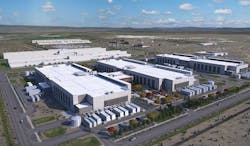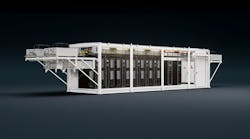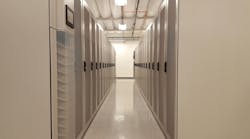As it continues a massive global expansion of its infrastructure, Facebook is rolling out a multi-story data center design featuring two floors of server rooms. The new design is being deployed in two new facilities at Facebook’s original data center campus in Prineville, Oregon.
Facebook has traditionally built data centers that house servers on a single story, with a second-floor “penthouse” dedicated to cooling systems. By adding a second story filled with data halls, Facebook can get more server capacity out of the real estate on its data center campuses.
Prineville is already the company’s largest cloud campus, with plans for 11 data center buildings. The new two-story buildings will add 900,000 square feet of capacity, bringing the total space deployed on the campus to nearly 4.6 million square feet. It has invested more than $2 billion in its infrastructure in Prineville, a central Oregon town of about 10,000 residents.
Large cloud and video services have been adding capacity to meet demand created by the COVID-19 pandemic. The world has gone online as never before, as COVID-19 precautions have shut down businesses, schools and entertainment venues. The sudden shift to digital work has driven a 30 percent surge in Internet traffic,
Building Up, Not Out
The move to taller buildings is a trend we first noted in 2017, as leading developers turned to vertical data center designs to boost their capacity to house IT gear. It’s a new direction for data center construction, which for many years focused on sturdy, single-story cement fortresses.
The trend is most pronounced in the hottest data center markets, Northern Virginia and Silicon Valley, where it’s becoming more difficult to find development sites for new construction projects. Google began building taller data centers in 2016, enabling it to pack more servers into the same real estate, providing more bang for its buck on each of its huge cloud campuses.
That’s a priority for hyperscale operators like Google and Facebook, who want more space to accommodate the rapid growth of their cloud computing operations. Facebook has continued to expand its data center footprint throughout the COVID-19 pandemic, announcing new data centers in Illinois and Tennessee, as well as major expansions of existing campuses in Utah, Georgia and Prineville.
Since it began building its own facilities in 2011, Facebook has consistently been enlarging the size of its campuses and its standard data center form factor. The company has been scaling up its infrastructure to handle massive growth in user photo and video uploads, including custom cold storage facilities and the use of BluRay disks to save energy on long-term storage.
Facebook’s largest data center is an 11-story facility in Singapore, a land-strapped market which is seeing growing demand for new capacity. The 1.8 million square foot facility will be one of the largest data center structures ever built, and the tallest facility yet that uses a true hyperscale design, which features larger facilities that capture economies of scale. The large parcels Facebook usually seeks to build its multi-building cloud campuses are largely unavailable in Singapore, an island nation where land is extremely expensive.
Hyperscale Thinking Focuses on Long Runways
As the Prineville project illustrates, hyperscale operators are building at a scale that requires long-term thinking about real estate and capacity. Facebook has typically built its campuses in suburban or rural areas where server farms could scale horizontally. It became common for single story facilities to spread out to make room for more capacity, spanning 300,000 to 500,000 square feet of space.
An illustration of the new buildings planned for the Facebook campus in Prineville, Oregon. (Image: Facebook)
It’s not immediately clear whether Facebook’s new design will include changes to the cooling system. Facebook’s multi-chambered penthouse design allowed for detailed filtering and cooling of fresh air, which enters the building through louvers on the upper floor. There are a number of methods for bringing fresh air into a server hall, including plenums positioned at the perimeter of a data hall rather than overhead. Illustrations of the new buildings show both horizontal and vertical louvers on several sides of the buildings. We have reached out to Facebook for additional details on the design update.
Multi-story designs have also become commonplace for developers building multi-tenant data centers. CoreSite has also been a pioneer in multi-story data centers, with facilities of four stories or taller in Chicago, Santa Clara and Reston, Virginia. Equinix recently has begun building four-story data centers in Ashburn and Dallas, and has a dedicated eight-story data center facility in Amsterdam, one of the most active data center markets in Europe. QTS, Digital Realty and others.
For a deeper dive on multi-story data centers, check out Vertical Data Centers: “Watts Per Acre” Guides Construction Economics. For more on Facebook’s expansion, see our Facebook Data Centers Channel.






